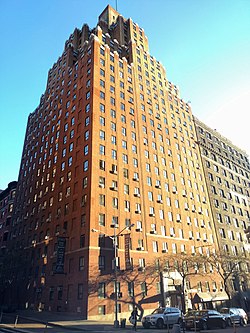
Streamline Moderne is an international style of Art Deco architecture and design that emerged in the 1930s. Inspired by aerodynamic design, it emphasized curving forms, long horizontal lines, and sometimes nautical elements. In industrial design, it was used in railroad locomotives, telephones, toasters, buses, appliances, and other devices to give the impression of sleekness and modernity.

Carew Tower is a 49-story, 574-foot (175 m) Art Deco building completed in 1931 in the heart of downtown Cincinnati, Ohio, United States, overlooking the Ohio River waterfront. The structure is the second-tallest building in the city, and it was added to the register of National Historic Landmarks on April 19, 1994. The tower is named after Joseph T. Carew, proprietor of the Mabley & Carew department store chain, which had previously operated in a building on the site.

The Hotel St. George is a building in Brooklyn Heights, Brooklyn, New York City. Built in sections between 1885 and 1930, the hotel was once the city's largest hotel, with 2,632 rooms at its peak. The hotel occupies the city block bounded by Pineapple Street, Henry Street, Clark Street, and Hicks Street.

The Majestic is a cooperative apartment building at 115 Central Park West, between 71st and 72nd Streets, adjacent to Central Park on the Upper West Side of Manhattan in New York City. It was constructed from 1930 to 1931 and was designed by the firm of Irwin S. Chanin in the Art Deco style. The Majestic is 30 stories tall, with twin towers rising from a 19-story base. The building is a contributing property to the Central Park West Historic District, a National Register of Historic Places–listed district, and is a New York City designated landmark.

The El Dorado is a cooperative apartment building at 300 Central Park West, between 90th and 91st Streets adjacent to Central Park, on the Upper West Side of Manhattan in New York City. It was constructed from 1929 to 1931 and was designed by architect of record Margon & Holder and consulting architect Emery Roth in the Art Deco style. The El Dorado consists of twin 12-story towers rising from a 17-story base. The building is a contributing property to the Central Park West Historic District, a National Register of Historic Places–listed district, and is a New York City designated landmark.
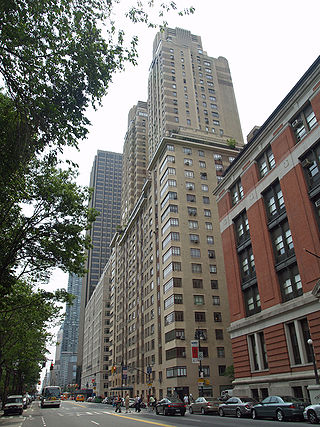
The Century is an apartment building at 25 Central Park West, between 62nd and 63rd Streets, adjacent to Central Park on the Upper West Side of Manhattan in New York City. It was constructed from 1930 to 1931 at a cost of $6.5 million and designed by the firm of Irwin S. Chanin in the Art Deco style. The Century is 30 stories tall, with twin towers rising from a 19-story base. The building is a contributing property to the Central Park West Historic District, a National Register of Historic Places–listed district, and is a New York City designated landmark.

First National Center, formerly known as First National Bank Building, is a prominent mixed-use skyscraper in downtown Oklahoma City. The art deco tower is 406 feet tall at the roof, and is 446 feet at its spire and contains 33 floors. The building was constructed in 1931 at an original square footage of 451,000 square feet (41,900 m2) by the First National Bank and Trust Company of Oklahoma City. Additions in 1957 and 1972 brought the square footage to 998,000 square feet (92,700 m2) of office space before the 2022 restoration and remodeling reduced it to 497,371 square feet (46,207.3 m2).

The Reynolds Building is a 314-foot (96 m) Art Deco skyscraper at 51 East 4th Street in Winston-Salem, North Carolina. It was completed in 1929 and has 21 floors with 313,996 square feet (29,171.2 m2) of space. For much of its history the building served as headquarters for R. J. Reynolds Tobacco Company. After a sale to PMC Property Group in 2014, the building went through an estimated $60 million in renovations. In March 2016, The Residences @ the R.J. Reynolds Building, apartments located on the top 11 floors, opened. The first six floors opened as the Kimpton Cardinal Hotel in April. Katharine Brasserie & Bar, a restaurant named for Katharine Smith Reynolds, followed in May.
Thor Equities is a real estate development, leasing and management firm, with headquarters in New York City, London and Mexico City. Thor Equities owns property in the United States, Canada, Europe, Russia, India and Latin America, including London's historic Burlington Arcade and the Palmer House Hilton. In New York City, Thor owns retail, office and residential properties on Fifth Avenue and Madison Avenue as well as in SoHo, Flatiron, the Meatpacking District, and Brooklyn including Coney Island. Thor also has investments in major U.S. cities including San Francisco's Union Square; Georgetown in Washington, D.C.; Robertson Boulevard in West Hollywood; Collins Avenue; Lincoln Road; Wynwood and the Design District in Miami. Thor offers investment vehicles for institutional investors through its Thor Urban Property Funds. Thor Equities also has several subsidiary companies including retail advisory and tenant representation firm Thor Retail Advisors.

The Beekman Tower, also known as the Panhellenic Tower, is a 26-story Art Deco skyscraper situated at the corner of First Avenue and East 49th Street in Midtown Manhattan, New York City. The building was constructed between 1927 and 1928 and was designed by John Mead Howells.

The Master Apartments, officially known as the Master Building, is a 27-story Art Deco skyscraper at 310 Riverside Drive, on the Upper West Side of Manhattan, New York City. It sits on the northeast corner of Riverside Drive and West 103rd Street. Designed by Harvey Wiley Corbett of the firm Helmle, Corbett & Harrison, in conjunction with Sugarman & Berger, the Master Apartments was completed in 1929 as the tallest building on Riverside Drive. It was the first skyscraper in New York City to feature corner windows and the first to employ brick in varying colors for its entire exterior.

1049 Fifth Avenue is a 23-floor luxury condominium apartment building located in the Upper East Side of Manhattan in New York City. Built in 1928 as the Adams Hotel, the building underwent extensive renovation in its conversion to residential condominiums during the years 1990–1993. When the apartments were first offered for sale in 1991, they were the highest-priced residential apartments ever listed in New York City. Their sale prices set city records in 1993 and 1994.

4/C, also known as 4th & Columbia, is a proposed supertall skyscraper in Seattle, Washington, United States. If built, the 1,020-foot-tall (310 m), 91-story tower would be the tallest in Seattle, surpassing the neighboring Columbia Center, and the first supertall in the Pacific Northwest. The project has been under development by Miami-based Crescent Heights since 2015 and undergone several design changes and modifications under three architecture firms. As of 2023, 4/C is expected to have 1,090 residential units—apartments up to the 64th floor and condominiums from the 65th to 90th floor—along with several coworking and retail spaces. The latest version was designed by Skidmore, Owings & Merrill.
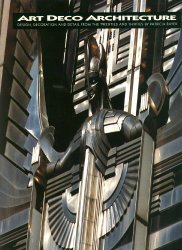
Art Deco Architecture: Design, Decoration and Detail from the Twenties and Thirties is an illustrated book by American art historian Patricia Bayer. The book was initially published in October 1992 by Harry N. Abrams. Patricia Bayer is an art historian living in Connecticut and writing extensively on Art Deco design. Her other books include Art Deco Interiors and Art Deco Postcards. The book contains 376 Illustrations, 146 in colour.
Bruce A. Menin is an American businessman. He is a managing principal of Crescent Heights, a real estate development company specializing in the development, ownership, and operation of residential and mixed-use real estate projects in the United States. Crescent Heights is based in Miami Beach, Florida, with regional offices in New York, Chicago, San Francisco and Los Angeles.

Crescent Heights, Inc, is an American real estate development company based in Miami, Florida, with offices in Chicago, New York, Los Angeles and San Francisco.

The Fitzroy is a ten-story residential building in the Chelsea neighborhood of Manhattan in New York City. The building was developed by Largo and JDS Development Group and designed by Roman and Williams, a New York City-based architecture and design team. It is the firm’s third building design, after 211 Elizabeth and the Viceroy Hotel.
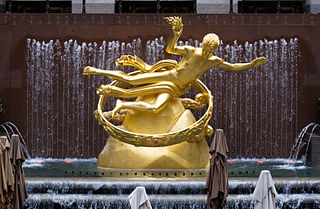
The Art Deco style, which originated in France just before World War I, had an important impact on architecture and design in the United States in the 1920s and 1930s. The most notable examples are the skyscrapers of New York City, including the Empire State Building, Chrysler Building, and Rockefeller Center. It combined modern aesthetics, fine craftsmanship, and expensive materials, and became the symbol of luxury and modernity. While rarely used in residences, it was frequently used for office buildings, government buildings, train stations, movie theaters, diners and department stores. It also was frequently used in furniture, and in the design of automobiles, ocean liners, and everyday objects such as toasters and radio sets.
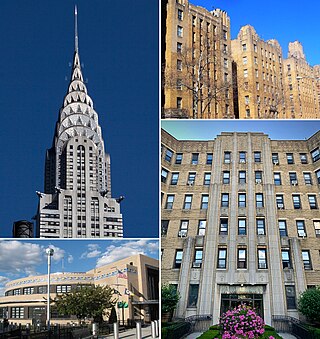
Art Deco architecture flourished in New York City during the 1920s and 1930s. The style broke with many traditional architectural conventions and was characterized by verticality, ornamentation, and building materials such as plastics, metals, and terra cotta. Art Deco is found in government edifices, commercial projects, and residential buildings in all five boroughs. The architecture of the period was influenced by worldwide decorative arts trends, the rise of mechanization, and New York City's 1916 Zoning Resolution, which favored the setback feature in many buildings.

The Sofia is a condominium building at the corner of Columbus Avenue and 61st Street on the Upper West Side of Manhattan in New York City. It was constructed from 1929 to 1930 and was designed by the firm of Jardine, Hill & Murdock in the Art Deco style for Kent Automatic Garages. The Sofia is 27 stories tall; the first nine stories above the ground level are used as offices, while the top 17 stories contain residential condominiums. The building is a New York City designated landmark and on the National Register of Historic Places.
